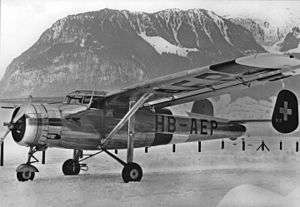Pilatus SB-2
| SB-2 Pelican | |
|---|---|
 | |
| Pilatus SB-2 | |
| Role | Four/six-seat light transport |
| National origin | Switzerland |
| Manufacturer | Pilatus Aircraft |
| First flight | 30 May 1944 |
| Number built | 1 |
|
| |
The Pilatus SB-2 Pelican was a civil utility aircraft developed by the newly formed Pilatus Aircraft company and the ETH Zurich during World War II.
Design and development
Work on the SB-2 Pelican, a special “slow-flying” aircraft, commenced in the winter of 1941.[1] Good short takeoff and landing credentials, plus steep climbing capabilities, were essential attributes of the aircraft flown in the narrow Alpine valleys at that time. The aircraft was designed to carry four to six passengers.[1]
The configuration of the SB-2 was slightly unusual, in that it was provided with tricycle undercarriage (an uncommon feature at the time), and a wing that had a slight forward sweep.[1]
Operational history
The SB-2 made its maiden flight on 30 May 1944.[2] After extensive trials, the only model built went to Alpar AG in Bern. The Pelikan was particularly well suited for passenger operations, but could also be used for aerial photography, survey flights, freight transport and agricultural work.
During an air display on 13 June 1948, the Pelican flipped over because the nosewheel sheared off from an unnoticed transverse fracture. It was damaged beyond repair.
| Pilatus ETH SB-2 Pelican | |
|
| |
|
| |
|
| |
|
| |
|
| |
|
|
Specifications (SB-2)
General characteristics
- Crew: one
- Capacity: up to five passengers
- Wingspan: 15.5 m (50 ft 10 in)
- Powerplant: 1 × Pratt & Whitney R-985 Wasp Junior , 336 kW (451 hp)
Performance
- Maximum speed: 250 km/h (155 mph; 135 kn)
See also
- Aircraft of comparable role, configuration and era
Notes
- 1 2 3 Jane's 1994, p. 203.
- ↑ Swiss Review of World Affairs, Volume 5/6, p. 152. Neue Zürcher Zeitung, 1955.
References
| Wikimedia Commons has media related to Pilatus SB-2. |
- Jane's Fighting Aircraft of World War II. Naval & Military Press Ltd. 1994. pp. 978–0517679647.